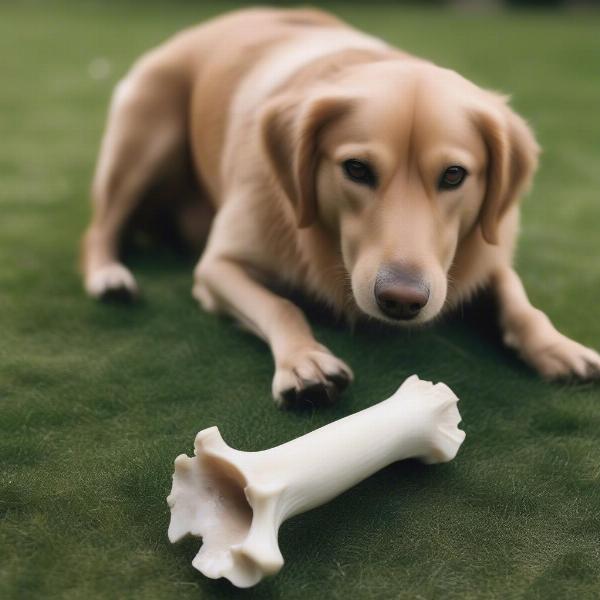Fresh marrow bones offer a variety of benefits for dogs, from dental health to mental stimulation. They’re a natural source of essential nutrients and provide hours of chewing enjoyment. But before you rush out and give your furry friend a bone, it’s important to understand the types of marrow bones, their benefits, and potential risks to ensure your dog enjoys this tasty treat safely.
Choosing the Right Marrow Bones for Your Dog
Not all marrow bones are created equal. For optimal safety and enjoyment, opt for beef femur bones. These are large, dense, and less likely to splinter than smaller bones. Avoid cooked bones entirely, as they become brittle and can easily break, posing a choking hazard. Raw bones are generally preferred, especially from reputable butchers who can advise on sourcing and preparation. Always supervise your dog when they’re enjoying a marrow bone.
Benefits of Fresh Marrow Bones for Dogs
Fresh marrow bones provide a range of health benefits:
- Dental Health: The act of gnawing on a marrow bone helps scrape away plaque and tartar buildup, promoting healthy teeth and gums. This can contribute to fresher breath and prevent dental disease.
- Mental Stimulation: Chewing on a marrow bone provides mental enrichment, helping to alleviate boredom and reduce anxiety. This can be especially beneficial for dogs prone to destructive chewing behaviors.
- Nutritional Value: Marrow is a rich source of essential fatty acids, vitamins, and minerals, contributing to a healthy coat, strong bones, and overall well-being.
Potential Risks and Precautions
While fresh marrow bones offer numerous benefits, there are also potential risks to be aware of:
- Splintering: While less likely with larger bones like beef femurs, splintering can still occur. Always supervise your dog and discard any bones that show signs of cracking or splintering.
- Choking Hazard: Small bone fragments can pose a choking hazard. Choose appropriately sized bones for your dog and monitor them closely during chewing sessions.
- Digestive Upset: Some dogs may experience digestive upset, such as constipation or diarrhea, after consuming marrow. Introduce marrow bones gradually and monitor your dog’s reaction.
 Dog Enjoying a Marrow Bone
Dog Enjoying a Marrow Bone
How to Prepare and Serve Marrow Bones
Thoroughly wash the bones before giving them to your dog. You can offer the bones frozen or thawed. Frozen bones can last longer and provide a more extended chewing experience. Discard the bone after a few days, or when it becomes small enough to be a choking hazard.
Alternatives to Fresh Marrow Bones
If you’re concerned about the potential risks of marrow bones, several alternatives offer similar benefits:
- Filled dog bones: These offer a safer, long-lasting chewing experience and can be filled with tasty treats. filled dog bones
- Bone marrow dog treats: These are a convenient and mess-free way to provide the nutritional benefits of marrow without the risk of splintering. bone marrow dog treats
- Antler chews for dogs: Antler chews are a naturally shed and long-lasting chew option, rich in minerals and promoting dental health. antler chews for dogs
Conclusion
Fresh marrow bones can be a healthy and enjoyable treat for your dog when offered responsibly. By choosing the right bones, understanding the potential risks, and taking appropriate precautions, you can ensure your furry friend reaps the benefits of this nutritious and delicious treat. Remember to always supervise your dog while they’re enjoying their marrow bone.
FAQ
- Are cooked marrow bones safe for dogs? No, cooked bones become brittle and can splinter, posing a serious choking hazard.
- How often can I give my dog a marrow bone? Start with one bone every few weeks and monitor your dog’s reaction.
- What size marrow bone is appropriate for my dog? Choose a bone that is too large for your dog to swallow whole.
- Can puppies have marrow bones? Yes, but supervise them closely and choose smaller bones appropriate for their size.
- What should I do if my dog swallows a bone splinter? Contact your veterinarian immediately.
- Can I give my dog marrow bones if they have dental issues? Consult your veterinarian before giving marrow bones to a dog with existing dental problems.
- Are there any breeds that shouldn’t have marrow bones? Dogs with aggressive chewing habits or a history of broken teeth may not be suitable candidates.
Dr. Emily Carter, DVM, a veterinary nutritionist based in London, recommends, “Introducing marrow bones gradually can help avoid digestive upset. Always monitor your dog’s stool after they’ve enjoyed a marrow bone.”
Dr. David Miller, PhD, a canine behaviorist, adds, “Chewing on marrow bones provides valuable mental stimulation and can be a great way to reduce boredom and anxiety in dogs.”
ILM Dog is a leading online resource for dog owners worldwide, dedicated to providing expert advice on all aspects of dog care, from breed selection to nutrition, training, and health. We connect you with the latest information and trends in the pet industry to ensure your furry friend receives the best possible care. For expert advice on dog nutrition, health, or any other dog-related concerns, connect with us via email at [email protected] or call us at +44 20-3965-8624. ILM Dog is your trusted partner in responsible dog ownership.